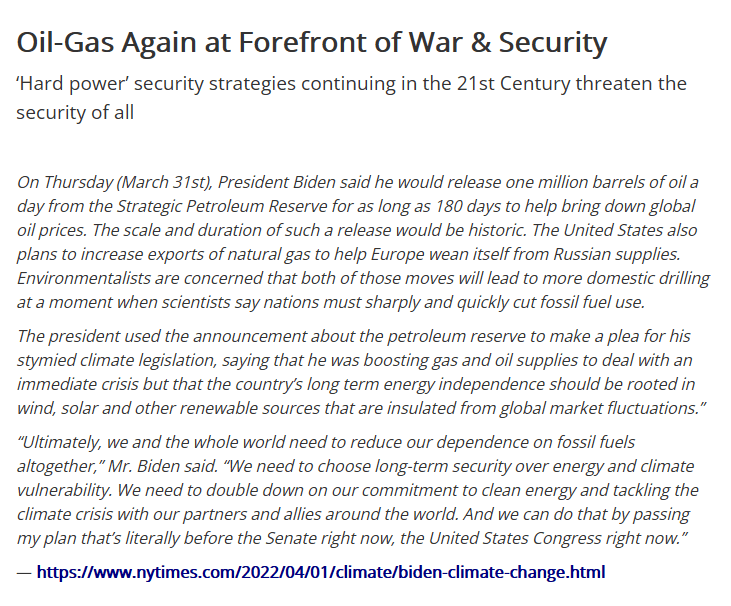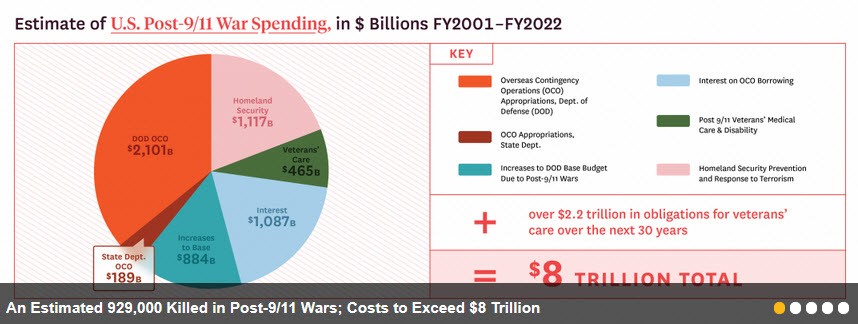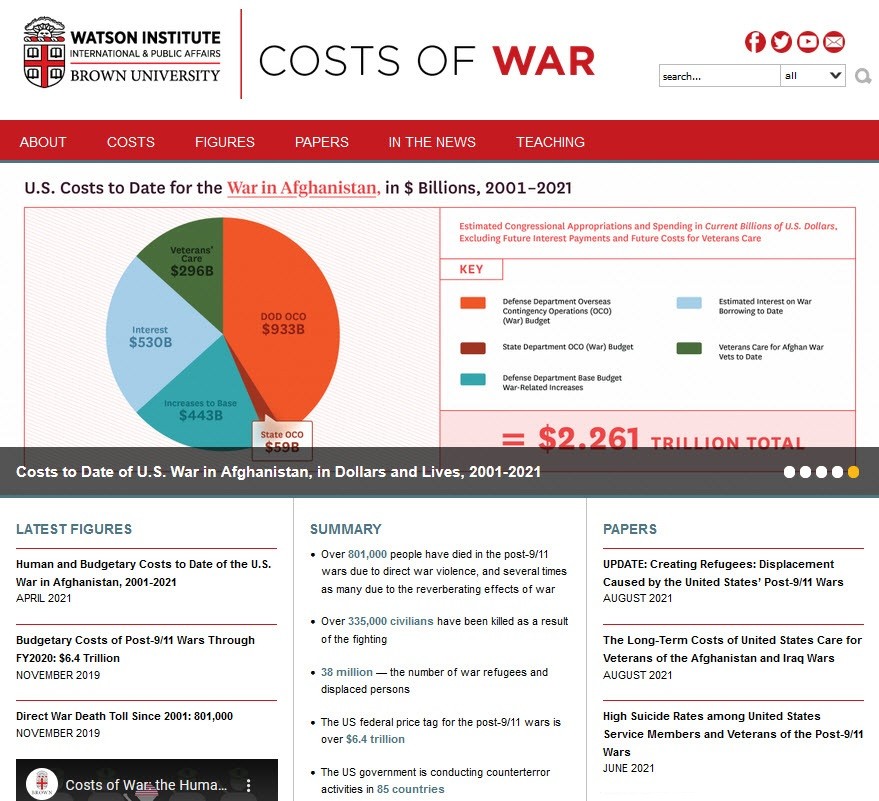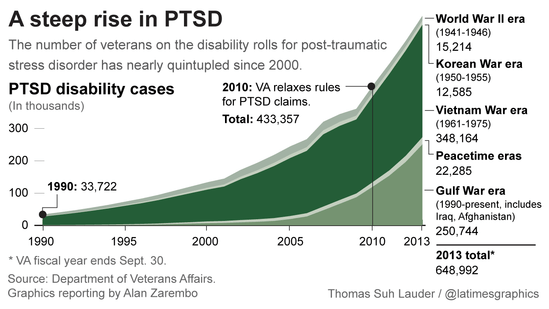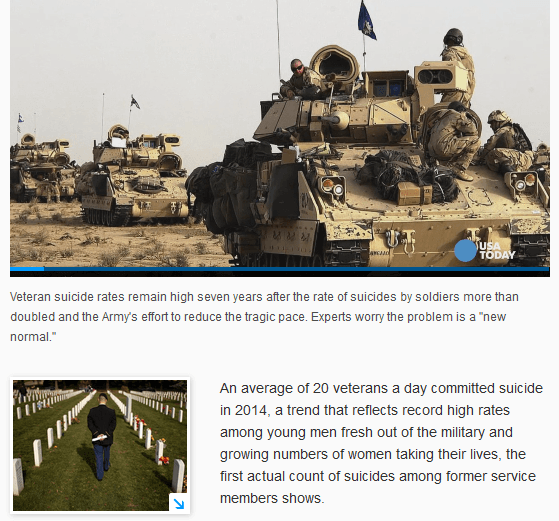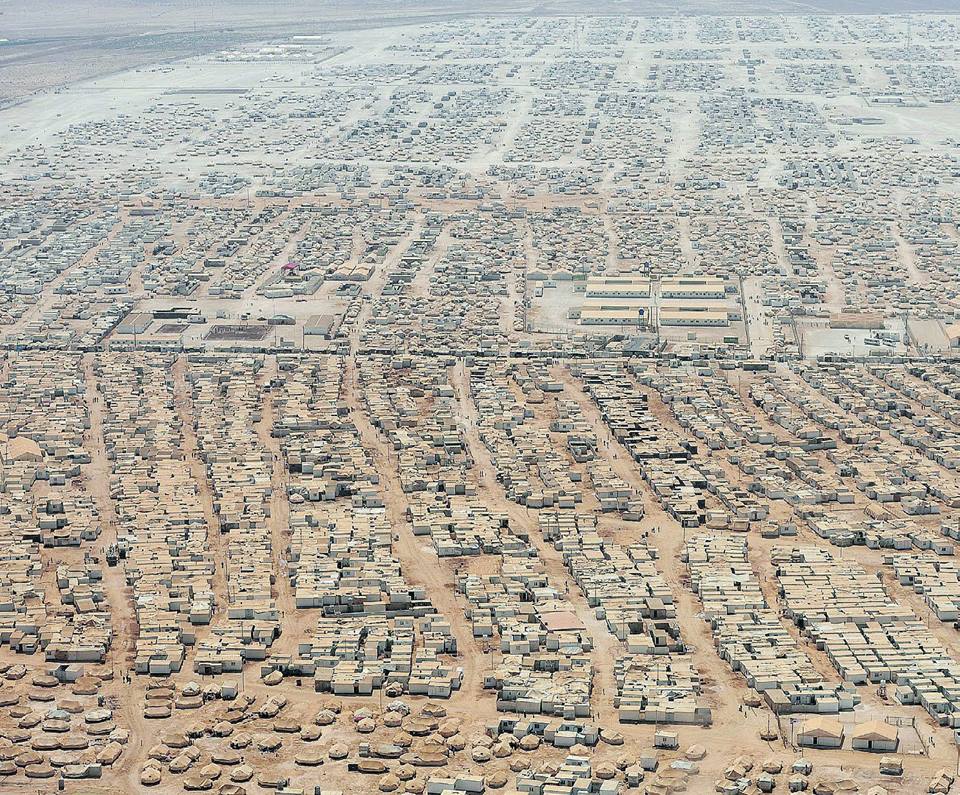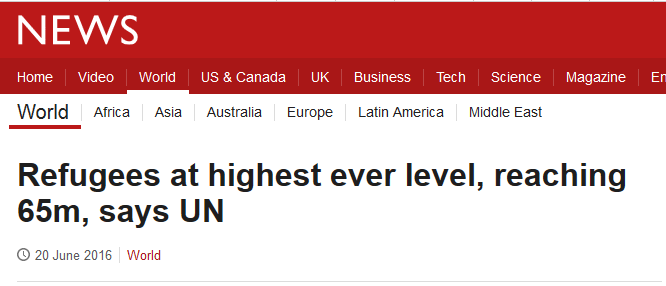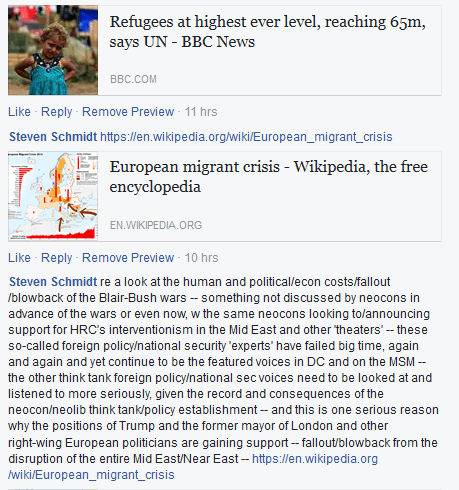Failed Policies, ‘Perpetual War’
- War Costs — profoundly understated
- Definitions of national security — outdated
- Nuclear risks of a Cold War 2.0 are escalating
- The nation ignores larger existential security threats
The U.S. is facing a crisis of governing, and loss of popular support. Decades of war have delivered deep costs, war costs that, even when calculated, do not come close to the reality of failed U.S. wars across the globe.
A trillion dollar annual Military-Industrial Complex budget and tens of billions in new global ‘War on Terror’ spending fail to capture the costs of not investing at home, not delivering on the promises of democratic decision-making, not offering an American dream of human rights and a promise of opportunity. The moral position of the nation has been damaged deeply at home and overseas. Some 800 overseas U.S. bases project hard power — and produce failed security.
Instead of ‘hard power’ delivering security, regional and global conflicts multiply and a new version we call Nuclear Arms Race 3.0 has commenced and is accelerating.
It’s time re-think, to move from old ways of thinking. It’s time to recognize the grave security threat facing all nations in the form of climate change and its disruption of life on Earth. Our generational responsibility is to the future, today, to become a Generation Green with new ways of seeing security and moving to climate action now.

It is Time for New Vision
An alternative strategic vision, a reality check is needed. Strategic Demands’ offers New Definitions of National and Global Security as a start, a plan, a countervailing voice and “physics of peace” against the current “calculus of war”.
Simply put — Perpetual War is no sane path to peace.
_____
2024
https://strategicdemands.com/snapshot-of-nuclear-arms-race-3-0/
______
2023
https://strategicdemands.com/the-movement-and-the-madman/
______
2022
______
2021
Estimate of U.S. Post-9/11 War Spending – FY2001-2022
Human Cost of Post – 9/11 Wars: Direct War Deaths in Major War Zones (as of 2019)
Millions (~38 Million) displaced by U.S. post-9/11 wars (as of 2019)
Long-term Care of U.S. War Veterans / Est. Between $2.2 and $2.5 Trillion by 2050
______
2020
The Coming Decade, Costs & Dangers Proliferate
A “Cold War 2.0” looms, a proliferation of nuclear powers that will become a new threat horizon. U.S. spending, costs and risks of catastrophic mistake are about to increase with nextgen ‘usable, smart’ nuclear weapons. Delivery forces soon to be deployed will, in turn, result in a reality that William Perry calls the most dangerous nuclear era since the height of the first Cold War. Neither candidate speaks of an alternative, a new direction or new definitions of national security.
Costs and Risks of a New Era of Nuclear Weapons ‘Modernization’
As nuclear weapons treaties are abandoned
Few in the strategic policy world are considering the broadened threats of escalation and new destructive war scenarios that will accompany the deployment of next generation nuclear weapons.
The absence of serious, deep discussion and debate in the US over this upcoming high-risk era of nuclear weapons escalation, with nuclear weapons scheduled to roll out over two decades should give alarm. It hasn’t. Instead, one of the US candidates for president in the fall of 2016 announced his willingness to use nuclear weapons and has announced a policy that would proliferate nuclear weapons to the Far East and throughout Europe.
The threats of nuclear war, in an approaching era of ‘smart’ nuclear weapons, for example, the re-designed (re-tasked) B61-12 is no idle threat to the US strategic opponents Russia and China. The capabilities of the soon-to-be-deployed F-35, capable of and designed to carry tactical (‘usable’) nuclear weapons are producing counter-measures and a next generation ratcheting up of the three ‘superpowers’ nuclear capability arsenals.
The lessons of the Cold War, the ‘close calls’, near disasters, catastrophes, miscalculations that almost became reality, historic moments as the world came perilously close to a nuclear Armageddon are being ignored and forgotten. The lack of financial incentive and resources extended to the strategic policy intellectual community are obvious, as nuclear powers ramp up their strategic, tactical, mobile, retaliatory nuclear weapons systems. Yet, few notice or point out the rising risks as the pressing quotidian day-to-day demands of business, and paychecks, are of the first order.
Strategic Demands position is to continue policies that do not deliver security.
It is time to look to the larger security horizon. It is time to assess the costs of war to the people who have experienced war — the very real risks and threats of larger war, economic and environmental breakdown, and a failed vision of what is possible and what changes in course should be and must be taken for assured national security, not assured mutual destruction.
At Strategic Demands we look to larger security issues beyond the norm of traditional U.S. ‘think tank’ assessments of foreign policy and national security threats.
Dollars and Costs Beyond Dollars
The war cost for the U.S. (without considering costs to other nations) one can begin with an estimated 1.25 Trillion in U.S. hard dollar defense and war spending annually. This profound cost in dollars does not taking into account immense opportunity costs, domestic investments lost, infrastructure neglected, psychological damage, global push back, lost allies, war population migration, international political consequences, exacerbated arms races, nuclear weapons escalation and a denial of evident existential risks, such as climate change. The global impacts of what has been called “perpetual war” are overlooked, the economic and environmental breakdowns, biodiversity losses, the mass extinctions of our era, the sustainable economic practices that have been set aside. The costs of modern, incessant war are deep costs amounting to a loss of national and global security…
The wars in Iraq and Afghanistan have lasted over two decades now, costing the United States upwards of 6 trillion USD since the first Iraq war in 1990.
The “true price” cost goes far beyond dollars and speaks to policy and strategy that has failed across the horizon, beyond the Mideast region, a global myopic, shortsighted vision that demands to be reset as the full-cost is not sustainable.
One of StratDem’s mandates will be to look more closely at realistic costs of war policies that, in our perspective, have set back overall security and set in motion generational security risks.
It is our belief that the full-costs of war must be taken into account as we look toward several decades now of U.S. military engagements globally and consequences that accrue from decisions to exercise “hard power”.
We will be focusing on costs of war writ large. Our intent is to raise hard questions, to look to the longer term, to develop a ‘new vision for the 21st century’, a vision that considers a larger horizon.
Up and down the military chain of command, in legislative bodies, in private enterprise, in public institutions and even religions, few are willing to take on the risks of questioning the larger costs associated with war appropriations, spending, and escalating risks that go beyond the latest headlines.
Direct costs of war are a point to begin discussion and debate. Beyond this are questions of larger costs. Indirect costs. The multiplier effect and calculus of prolonged wars. “Long wars” have exponential costs, yet there is not much ‘upside’ in identifying the deep costs of policies funded and supported by industrial interests, as once spoken of by Dwight Eisenhower.
Over the decades, the consequences of war remain too real to dwell upon, whether economic or human, as in “Victims of War Are Not To Be Seen Or Heard Or Mentioned“, the business of war goes forward and the costs are set aside. As the wars in the Middle East move toward a fourth decade, and larger conflict grows, now is a time to look at the full costs, the opportunities lost, the potential lost, the reverberating toll that lasts for generations. The considerable costs must be seen, heard, and mentioned.
Peter Van Buren:
If America accepts the idea of fighting endless wars, it will have to accept something else as well: that the costs of war are similarly endless. I’m thinking about the trillions of dollars, the million or more “enemy” dead (a striking percentage of them civilians), the tens of thousands of American combat casualties, those 20 veteran suicides each day, and the diminished lives of those who survive all of that. There’s that pain, carried by an unknown number of women and men, that won’t disappear, ever, and that goes by the label “moral injury.”
The price of endless war is beyond calculation. As our wars continue to morph and roll on, the costs — financial, emotional, and in blood — only pile up as the men and women who have been welcomed home as if it were all over continue to be torn apart.
The conclusion extends the moral injury: that our endless wars and conflicts create our society, one that just can’t stop itself from making war …

Costs, Far Beyond the VA Reported Numbers
CNN / As of September 2014, more than 307,000 pending ES (enrollment system application) records, or about 35 percent of all pending records, were for individuals reported as deceased by the Social Security Administration. Hundreds of thousands of veterans listed in the Department of Veterans Affairs enrollment system may have died before their applications for care were processed, according to a report issued in September 2015.
Costs, On the Ground Truth
Reality Check, Triage and ‘Surviving Victory’
As of the first decade in the 21st century, millions of U.S. soldiers have been deployed overseas and have returned with physical and emotional wounds and ongoing difficulties readjusting to everyday life. They are neglected, they should not be.
The U.S. Congress criticizes the Veteran’s Administration system after the same Congress spends trillions on war over the past decade, in the Mideast and extended conflicts, without adequately accounting for the full-costs and true-costs of war policies.
Congress appropriates, borrows and spends trillions overseas adding to the nation’s debt, while calls for escalation continue. Congress spends to an extent that it adds a security threat of its own making as it is a proximate factor in a financial/banking meltdown that threatens the U.S. and international economy.
Yet, few regard the decade’s war spending with clear-eyed vision as misplaced priorities that led to near financial collapse/crisis/breakdown and underfunding of a host of domestic needs which have led, in turn, to costly impacts. The U.S. political system is universally regarded as ‘broken’ and pay-to-play politics of access and partisanship obstructs needed actions. Essential needs such as the VA are relegated to one of multiple essential needs unmet/unfunded as a result of misplaced priorities.
In the U.S. Congress the full costs of war are rarely discussed and debated, rarely is there a demand for a full accounting of the ‘true costs’ of failed policy and decades of war.
Strategic Demands examines the unaccounted costs, true costs, full costs of war beyond the ‘direct accounting’ numbers of the U.S. government and mainstream media/MSM reporting (i.e., current estimates of Iraq – Afghanistan war spending are regularly reported as approximately $2 trillion (USD), far below $6+ trillion dollars reported by authoritative sources. Related costs, opportunity costs, psychological costs, intergenerational costs rarely come into the light.)
StratDem War Beat – B1; B2; B3; B4 (Bilmes – Stiglitz); B5; B6; B7
A Persian Gulf war study conducted at Princeton University estimates that the U.S. spent $6.8 trillion dollars from 1976 to 2007 — three percent of total GDP — defending oil shipments in the Persian Gulf.
If the U.S. government hadn’t spent that money defending Middle Eastern seaways and instead invested far less than the average $225 billion per year at home, we would be oil independent.
Mainstream media reported costs of war in Iraq/Afghanistan but rarely reported any estimate of war-related costs, costs over time, damages, lost opportunities, lost business, lost credibility, lost moral suasion…
The issues here go far beyond ‘blood and treasure’ to larger questions transcending two-party governance in the U.S.
The questions of war go to human costs, costs today and tomorrow, international politics and global security questions.
Watson Institute’s Continuing “Costs of War” Report
Human Costs
As StratDem is published in the US, we begin to look at human costs by looking at homeland human costs and extending the larger costs to the Mideast and, increasingly, the escalation of conflict across borders that threatens broader and more costly conflicts. The linkage of Mideast conflict to global conflict is evident and continues to escalate weapon modernization and policies of the US, Russia, China and worldwide war costs.
Today, citizens of the United States directly bear the burden of more than 150 years of warfare. As of May 2016, the VA was still paying benefits to one dependent of a Civil War (1861-1865) veteran, 88 dependents of Spanish-American War (1898-1902) veterans, nine dependents of veterans of the military campaign along the Mexican border early in the twentieth century, thousands of dependents of World War I (1917-1918) veterans, hundreds of thousands of World War II (1941-1945) veterans and dependents, hundreds of thousands of Korean War (1950-1953) veterans and dependents, around 1.8 million Vietnam War-era (1964-1975) veterans and dependents, and millions of veterans and dependents of the Gulf War (1990-1991) and of the ongoing War on Terror campaigns in Iraq, Afghanistan, and elsewhere (2001 to the present).
— Via TomDispatch, August 25, 2016, How Veterans Are Losing the War at Home
They Were Soldiers: How the Wounded Return from America’s Wars: The Untold Story
Breach of Trust: How Americans Failed Their Soldiers and Their Country
The Colonel, the Veteran and the Caregiver
US Veterans
Approximately 250,000 of the 697,000 U.S. veterans who served in the 1991 Gulf War are afflicted with ‘Gulf syndrome’, enduring chronic multi-symptom illness, a condition with serious consequences.
http://www8.nationalacademies.org/onpinews/newsitem.aspx?RecordID=12835
http://www.va.gov/gulfwaradvisorycommittee/docs/GWIandHealthofGWVeterans_RAC-GWVIReport_2008.pdf
http://www.publichealth.va.gov/docs/epidemiology/ptsd-report-fy2012-qtr3.pdf
A 2012 report revealed that 247,243 veterans from the Iraq and Afghanistan Wars have been diagnosed with Post Traumatic Stress Disorder/PTSD, nearly 30 percent of the 834,463 Iraq and Afghanistan War veterans treated at V.A. hospitals. Estimates are that the overall PTSD rate is 20 percent across the entire population of Iraq and Afghanistan veterans, not just those who have come to a V.A. facility
http://www.publichealth.va.gov/docs/epidemiology/ptsd-report-fy2012-qtr3.pdf
“PTSD and the Truth”
via the LA Times
___________________________________________________________
The statistics tell the tragic story. Veterans in 2014 were killing themselves at three times the rate of civilians and at a quickening pace, up by a third from 2001 to 2014. Most self-destructive are young male veterans in their 20s, who are dying at four times the rate of their civilian peers. Female veterans were 2.4 times more likely to choose suicide than civilian counterparts.
In one narrow category — 18- to 24-year-old male veterans who served in Iraq or Afghanistan and were VA patients — the suicide rate was 10 times the national average for all people.
_______________________________________________________________
Incarceration / Industrial Prison Complex
As of 2013, approx. 700,000 Veterans are incarcerated or under criminal justice supervision in the US
https://www2.nami.org/Template.cfm?Section=CIT&Template=/ContentManagement/ContentDisplay.cfm&ContentID=165849
http://mic.com/articles/86519/19-actual-statistics-about-america-s-prison-system
http://www.justiceforvets.org/vtc-impact
VA Secretary Eric Shinseki: “Nearly 58,000 [veterans] are estimated to be homeless on any given night. I am told that incarceration is the No. 1 predictor of homelessness.
“If we are going to break the cycle between incarceration and homelessness, we will have to raise our level of collaboration and leverage all our assets to address these factors, which seem so pervasive when dealing with troubled Veterans—depression, insomnia, substance use disorder, pain, failed relationships.”
_______________________________________________________________________
Disaster in the Mideast
25 Years+ of War / Civilian deaths / Devastation
Using the 2005 census total of 4,050,597 households in Iraq, polling of households suggests 1,220,580 deaths since the US led Iraq invasion. The ORB polling reports, “We believe the range is a minimum of 733,158 to a maximum of 1,446,063.”
Most mortality increases in Iraq can be attributed to direct violence, but about a third are attributable to indirect causes (such as from failures of health, sanitation, transportation, communication, and other systems). Approximately a half million deaths in Iraq could be direcly attributable to the war conflict.
http://www.plosmedicine.org/article/info%3Adoi%2F10.1371%2Fjournal.pmed.1001533
US/UN sanctions on Iraq of the 1990s, which interdicted chlorine for much of that decade and so made water purification impossible, are estimated to have killed another 500,000 Iraqis, mainly children. (Infants and toddlers die easily from diarrhea caused by gastroenteritis, which causes fatal dehydration).
http://www.juancole.com/2013/10/american-population-sanctions.html
At a minimum, 134,000 civilians have been killed by war’s violence since 2003 in Iraq. But many deaths in Iraq were unreported or unrecorded: thus, estimated number of deaths, based on tallies of government and press reports, is an undercount. If a full recording of Iraqi violent deaths due to war were to be made, the toll could be twice as high, according to Iraq Body Count (IBC), the one organization that has attempted to document all the violent deaths in Iraq that have resulted from the initiation of war ten years ago. Thus, the toll of violent death due to war may be 250,000 or more people.
The number of Iraqi men, women and children who been seriously injured in the war is about the same as the number killed. In addition, many times the number killed by direct violence have likely died due to the effects of the destruction of Iraq’s infrastructure. Some of these numbers are disputed some officials might argue that this is an over estimate of the effects of war on Iraqi civilians; many more would argue that these estimates aren’t cautious.
http://costsofwar.org/sites/all/themes/costsofwar/images/Civilian_Death.pdf
◊
Migration Crisis Today & Tomorrow
UN: World facing greatest humanitarian crisis since 1945
http://www.bbc.com/news/world-africa-39238808 #MigrationCrisis
Millions of displaced civilians continue to seek shelter from current wars, month-by-month, year-by-year.
Millions of people are being impacted by climate change disruption, millions more will be forced to migrate.
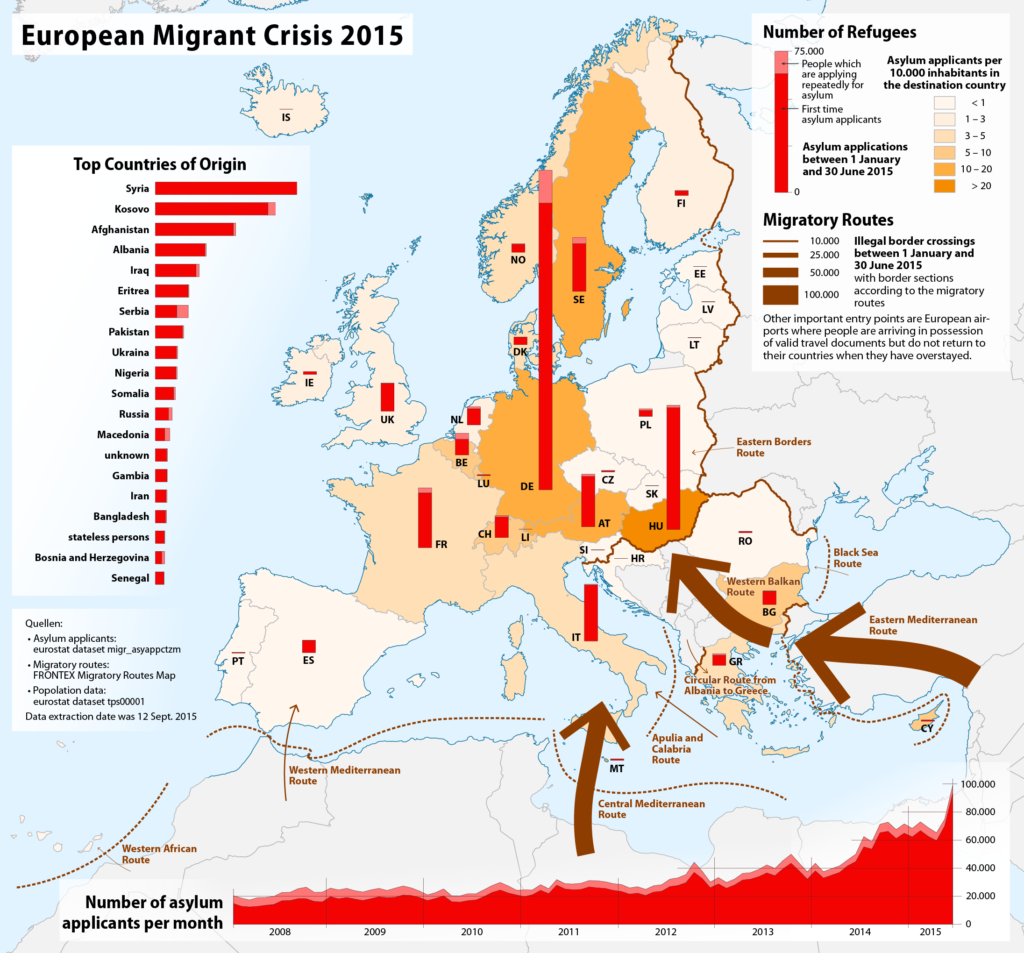
http://www.haaretz.com/news/middle-east/1.674759
http://www.cnn.com/2015/09/04/europe/migrant-crisis-country-by-country/
http://www.cnn.com/2015/09/06/europe/europe-migrant-crisis/
___________________________________________________________
Geopolitics
Proliferation
The rising tensions in the Mideast are producing increasing tensions between the US, China and Russia.
Strategic experts and military advisers review options amid increasing weapon system budgets, nuclear weapon systems ‘modernization’, a “new nuclear arsenal” with new uses, and belligerent moves unseen seen the height of the Cold War.
The Russia-China military relationship grows on multiple fronts — tech transfer, accepted reverse engineering, shared intel, cyber linkage, defense assistance, joint exercises, a “new missile age” that features new and advanced ballistic and cruise missiles, conventional and nuclear, stand off and penetrating, offensive and defensive, land, sea and air.
The resurgence of Russian-U.S. conflict, and Russian-Chinese alignment, presages a new Cold War, which StratDem is now calling Cold War 2.0. This new ‘grand game’ augers new risks, escalation, proliferation, and strategies.
The Chinese now act in a stark contrast to past Cold War lines, a profoundly greater force, economic, a rising Eurasian and global power with increasing nuclear capabilities. A near future of rising tensions with the US will play out against a backdrop of Chinese-Russian strategic alliances and moves across the Eurasian continent.
The former Russian Chief of the Main Staff of the Strategic Rocket Forces and current Professor at the Academy of Military Sciences of the Russian Federation, Colonel Viktor Yesin, speaks to this in a revealing strategic review made public —
https://strategicdemands.com/wp-content/uploads/2015/01/YESIN-China-s-Nuclear-Potential_2012.pdf
China’s nuclear capabilities, in absence of multilateral nuclear agreement, continue to escalate.
The Chinese_Russian relationship is no longer the adversarial relationship of the Cold War, but rather an alliance around multiple economic, energy, and strategic agreements.
Chinese export of weapons is on the cusp of profound change, as Chinese advanced weapon capabilities expand each year.
China’s international trade exceeds that of the U.S. as statistics increasingly demonstrate — with arms sales next to be added to the numbers.
https://twitter.com/hashtag/nukefest
http://carnegieendowment.org/2015/02/02/2015-carnegie-international-nuclear-policy-conference/i3o5
* China has become No1 economic power in Asia and is now 2nd world destination for investment, and 3rd source of investment
* China is lead economic player in Asia. Perception in #US that dollar will be main currency, but not so in Asia
* The number of countries that have China as their top trading partner: China: 123, US: 63
An “Asia pivot” and re-balancing of U.S. interests in Asia is a great challenge in the making — as the U.S. continues the expense, and misguided policy, of trillions spent in the greater Middle East on decades of economically damaging, and consequential opportunity-cost wars. Beginning in 1990 with the first Iraq war and since, the U.S. has run up trillions in new war-spending debt and costs beyond the ledger sheet.
Nuclear tensions are high, with the U.S. for the first time publicly acknowledging the nuclear capabilities of Israel, as Israel threatens war with Iran.
http://www.thenation.com/blog/202129/its-official-pentagon-finally-admitted-israel-has-nuclear-weapons-too
http://www.thenation.com/blog/201369/what-about-israels-nuclear-bomb
Iran’s energy agreements with China and Russian further entangle and threaten. While the U.S. budget goes into deep deficit to support trillions in war spending and as the US infrastructure and social investment deteriorates due to war spending, the Eurasian infrastructure outreach of China is a massive trillion plus, multi-decade investment-in-the-making. The geo-politics of the future is more than a ‘grand strategy‘, a global ‘great game‘ reminiscent of the 19th century but now worldwide, it is a rising threat horizon that encompasses traditional ‘game play’ and new definitions of national security brought on by global environmental threats.
Look at the rising threat horizon — nuclear proliferation in a developing 2.0 Cold War, an ‘existential’ yet clouded future threat of atmospheric and planetary eco-related disruptions, climate change, water depletion with droughts, mass migration with failed states, conflicts and hot spots turning regional and international with entangling alliances drawing in the players as ‘falling dominoes’ and recalling an early 20th century era world war that spiralled out of control.
The US Congress now budgets war globally, hundreds of bases and conflicts, as pre-emptive wars are normalized and the phrase “perpetual war” is no longer seen as hyperbolé.
These are days of multiplying security risks. The dynamics of a physics of peace as opposed to a calculus of war are playing out. The grand game continues on, and is being redefined, in the 21 century.
Ⅰ Ⅱ Ⅲ Ⅳ Ⅴ Ⅵ Ⅶ Ⅷ Ⅸ Ⅹ Ⅺ Ⅻ
Strategic Demands content can be shared under a Creative Commons Attribution 4.0 International License

